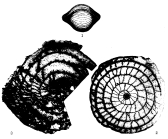Foraminifera taxon details
Rugososchwagerina Miklukho-Maklay, 1959 †
721863 (urn:lsid:marinespecies.org:taxname:721863)
accepted
Genus
Schwagerina yabei Staff, 1909 † accepted as Rugososchwagerina yabei (Staff, 1909) † (type by original designation)
- Species Rugososchwagerina altimurica Leven, 1997 †
- Species Rugososchwagerina fosteri (Thompson & Miller, 1935) †
- Species Rugososchwagerina heratica Leven, 1997 †
- Species Rugososchwagerina heteromorpha Xie, 1982 †
- Species Rugososchwagerina lingula Xie, 1982 †
- Species Rugososchwagerina quasifosteri (Sheng, 1956) †
- Species Rugososchwagerina xizangica Wang, Sheng & Zhang, 1981 †
- Species Rugososchwagerina yabei (Staff, 1909) †
- Species Rugososchwagerina zagroensis Davydov & Arefifard, 2013 †
- Species Rugososchwagerina zhongguoensis Chen, 1977 †
- Subgenus Rugososchwagerina (Xiaoxinzhaiella) Shi, Yang & Jin, 2005 † accepted as Xiaoxinzhaiella Shi, Yang & Jin, 2005 † (unaccepted > superseded rank)
- Species Rugososchwagerina ferganica Miklukho-Maklay, 1956 † (unaccepted > nomen nudum)
- Species Rugososchwagerina insolita Davydov in Chediya et al., 1986 † accepted as Kubergandella insolita (Davydov in Chediya et al., 1986) † (Opinion of Leven (2009))
- Species Rugososchwagerina kansasensis (Beede & Kniker, 1924) † accepted as Paraschwagerina kansasensis (Beede & Kniker, 1924) †
- Species Rugososchwagerina xanzensis Wang, Sheng & Zhang, 1981 † accepted as Xiaoxinzhaiella xanzensis (Wang, Sheng & Zhang, 1981) † (unaccepted > superseded combination, Opinion of Shi et al. (2005))
marine, brackish, fresh, terrestrial
fossil only
feminine
Miklukho-Maklay, A. D. (1959). Значение гомеоморфии для систематики фузулинид - The significance of homeomorphy in the systematics of Fusulinids. <em>Уч. зап. ЛГУ, сер. геол.</em> 19(268): 155-171.
page(s): p. 160 [details]
page(s): p. 160 [details]
Diagnosis Test large, up to almost 12 mm in length, subspherical or with slightly protruding poles, earliest four to five volutions...
Diagnosis Test large, up to almost 12 mm in length, subspherical or with slightly protruding poles, earliest four to five volutions form a tightly coiled fusiform juvenarium around the very small proloculus, nine or ten septa in the earliest whorl increasing to twenty or more by the fourth whorl, juvenarium followed abruptly by four to five more loosely coiled whorls that increase rapidly in height and less rapidly in length to produce a more robust adult of up to forty-five septa per whorl, final whorl sharply reduced in height, septa intensely fluted in the juvenarium, the folds commonly reaching the top of the chamber but fluting restricted to the lower part of the septa in the inflated later stage; wall consisting of tectum and coarsely alveolar keriotheca, thin but slightly rugose in the early stage, thickening abruptly in later whorls, weak chomata and low and narrow tunnel in the juvenarium and in earlier whorls of adult stage. U. Permian (Darvasian to Murgabian); Italy: Sicily; Iran; Iraq; Afghanistan; China; USSR. (Loeblich & Tappan, 1987, Foraminiferal Genera and Their Classification) [details]
Hayward, B.W.; Le Coze, F.; Vachard, D.; Gross, O. (2025). World Foraminifera Database. Rugososchwagerina Miklukho-Maklay, 1959 †. Accessed at: https://www.marinespecies.org/foraminifera/aphia.php?p=taxdetails&id=721863 on 2025-05-20
Date
action
by
original description
Miklukho-Maklay, A. D. (1959). Значение гомеоморфии для систематики фузулинид - The significance of homeomorphy in the systematics of Fusulinids. <em>Уч. зап. ЛГУ, сер. геол.</em> 19(268): 155-171.
page(s): p. 160 [details]
basis of record Loeblich, A. R.; Tappan, H. (1987). Foraminiferal Genera and their Classification. Van Nostrand Reinhold Company, New York. 970pp., available online at https://books.google.pt/books?id=n_BqCQAAQBAJ [details] Available for editors [request]
[request]
page(s): p. 160 [details]
basis of record Loeblich, A. R.; Tappan, H. (1987). Foraminiferal Genera and their Classification. Van Nostrand Reinhold Company, New York. 970pp., available online at https://books.google.pt/books?id=n_BqCQAAQBAJ [details] Available for editors
From editor or global species database
Diagnosis Test large, up to almost 12 mm in length, subspherical or with slightly protruding poles, earliest four to five volutions form a tightly coiled fusiform juvenarium around the very small proloculus, nine or ten septa in the earliest whorl increasing to twenty or more by the fourth whorl, juvenarium followed abruptly by four to five more loosely coiled whorls that increase rapidly in height and less rapidly in length to produce a more robust adult of up to forty-five septa per whorl, final whorl sharply reduced in height, septa intensely fluted in the juvenarium, the folds commonly reaching the top of the chamber but fluting restricted to the lower part of the septa in the inflated later stage; wall consisting of tectum and coarsely alveolar keriotheca, thin but slightly rugose in the early stage, thickening abruptly in later whorls, weak chomata and low and narrow tunnel in the juvenarium and in earlier whorls of adult stage. U. Permian (Darvasian to Murgabian); Italy: Sicily; Iran; Iraq; Afghanistan; China; USSR. (Loeblich & Tappan, 1987, Foraminiferal Genera and Their Classification) [details]

